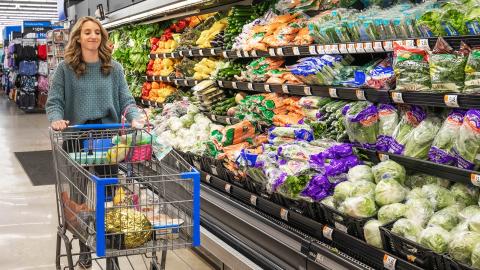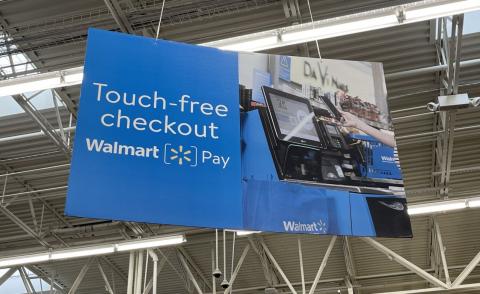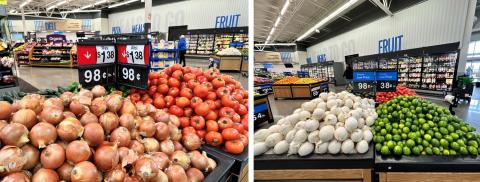Walmart Doubles Down on New Flywheel Business Model

Earlier this year, on a rare rainy day in Las Vegas, Walmart executives gathered together to lay out a vision for the future of the grocery retail industry.
At the CES Show, Walmart Chief Revenue Officer Seth Dallaire led a discussion with Cheryl Ainoa, SVP of new business and emerging technology; Julie Barber, EVP of general merchandise; Jill Toscano, VP of media; and Walmart Chief Economist John List. The topic of the conversation was the state of the company’s flywheel business model, first unveiled in 2021. Two years ago, President and CEO Doug McMillon described the company’s future business model as being based on three main pillars: e-commerce, financial services, and health and wellness. But at CES, Walmart execs detailed how that model has evolved to comprise a larger strategic innovation framework with three additional pillars: media, advertising and fulfillment services.
Just one example of how this new flywheel is spinning came in January, when Walmart teamed up with San Francisco-based Salesforce to get into the last-mile fulfillment business for other retailers. The partnership aims to help small and large retailers offer a “buy online and pick up” service for their customers through an app known as AppExchange. Walmart, which has often been accused of putting smaller retailers out of business, is now offering up its omnichannel order and delivery system to independent retailers to help them grow their businesses and serve more customers. The new service is part of Walmart’s larger push to scale higher-margin earnings streams.
“We’re continuing to invest for the future in ways that strengthen our retail advantages by expanding our capabilities and marketplace, ad platform, data ventures, and fulfillment as a service,” said John Rainey, CFO of Walmart, during the company’s fourth-quarter earnings call this past February. “We’re providing more convenience for customers, including pickup and delivery, Scan & Go, and Walmart Plus. We’re working in partnership with our suppliers and sellers to use data-scaled fulfillment capabilities and our growing ad platform to elevate inventory accuracy and in-stocks, lower the cost to serve, and drive improved conversion. We’re managing our costs in a way that allows us to achieve our operating income goals with these investments. In other words, we’re staying true to our commitment of everyday low cost, enabling everyday low prices.”

‘Naturally Hedged’
Like many food retailers operating amid this macro backdrop of recession risk, persistent inflation and higher food-at-home sales, Walmart, which operates 5,342 locations in the United States, was optimistic yet cautious when it reported strong fourth-quarter and fiscal 2023 earnings. Walmart’s U.S. division posted net sales of $113.7 billion, an 8.5% increase year over year. U.S. same-store sales rose 8.3% as the company continued to gain market share in grocery, especially among higher-income shoppers looking to save money. Specifically, the retailer said that strength in food sales (up by high teens) reflected continued market share gains and ongoing growth in private-brand penetration; grocery sales increased by low-20s percentages on a two-year stack. Food units sold increased year over year; transactions and baskets were higher, too. Walmart is attracting more shoppers of more income levels than ever before, thanks to its value prop promising better prices and more convenience options — such as membership, pickup and delivery — than traditional grocers and discounters.
“One of the things I’ve always appreciated about this company is that it’s naturally hedged,” McMillon said on the call. “If customers want more of something and less of something else, we shift our inventory. If the economy is strong, our customers have more money. If things are tougher, they come to us for value. With today’s inflation, we’re continuing to see that happen. We’re gaining share across income cohorts, including at the higher end, which made up nearly half of the gains we saw in the U.S.”
A lot of those higher-end shoppers love Walmart’s online grocery offering. Walmart now has more than 4,600 pickup locations and more than 3,500 same-day delivery locations across the United States. The company also has 157 distribution facilities, plus 31 dedicated e-commerce fulfillment centers. This month, Walmart revealed a revamp of its home page on desktop and mobile, with a customer-centric and curated storefront on walmart.com and the Walmart app so that customers can easily find what they need and be inspired to shop more of the hundreds of millions of items in the retailer’s online assortment.
“When we think about our business today, compared to what it was during prior economic downturns, we now have a more compelling offer, a true omnichannel experience that makes us optimistic that more higher-income families will continue shopping with us across categories because we have pickup, delivery and membership,” McMillon said.

Getting the Mix Right
Walmart’s last few quarters show that it has acted quickly and aggressively to address the inventory and cost challenges it faced last year. The company is also planning to accelerate automation in its fresh distribution.
“In our perishable DCs, where we put some automation in place, we had a plan that would result in increased throughput in terms of cases per hour,” Rainey said. “The actual results are almost 50% better than that. That gives us conviction to want to accelerate some of this. Same story with some of our e-commerce DCs, where we see a 12-step process going down to five steps, making us a lot more efficient. These are high-ROI investments where we’ve got clear line of sight into the return.”
The retailer is also working to improve the product mix as it tries to get shoppers to convert in higher-margin (nonfood) categories such as apparel and hard lines. Walmart has been opening health clinics (a footprint of nearly 50 locations by the end of this year) and remodeling thousands of stores to showcase apparel, beauty and other non-grocery categories, and that may already be working to elevate the retailer’s brand. It’s not unusual to see celebrity stylists on social media modeling clothes from Walmart’s Brandon Maxwell collection, for example. “I got it at Walmart” is now actually cool.
“The opportunity in front of us is incredible. Our customer member value proposition has never been stronger. Perhaps, that’s more obvious during times like this, when the consumer is pressured,” McMillon said. “Who else has the stores and clubs so close to so many customers and members, combined with first- and third-party e-commerce, and the combination of grocery and general merchandise? We’re in the right markets, with a breadth of assortment and ways of shopping like no one else, with impactful and emerging digital and technological capabilities.”
For fiscal 2023, Walmart added $38 billion in sales globally, and crossed $600 billion in revenue for the first time in the company’s history. Internationally, e-commerce now represents more than $80 billion in sales and more than 13% of total sales. Walmart U.S. grew sales by more than $27 billion. Sam’s Club U.S. grew sales by more than $10 billion as it delivered double-digit comp growth for the third consecutive year, with membership count at a record high and strong growth in membership income.
According to Sam’s Club, it plans to invest in opening at least 30 new clubs over the next several years, as well as a supply chain modernization initiative.
“If you look at the actual membership composition, we’re growing with mid to high household income groups with share of wallet,” said Kathleen McLay, CEO of Sam’s Club, on the call. “We’re growing with Millennials and Gen Z as the largest growth area in our membership base. Then, if I look at market share, we’re growing market share in our club channel despite not opening clubs while our competitors were opening clubs. So, if you look at that suite of metrics, you realize that the value proposition we have at Sam’s is winning.”
[Read more: "Walmart Reveals Growth Strategy, Next-Gen Supply Chain"]
In addition to its retail divisions, Walmart’s global advertising business grew more than 30% for the year to $2.7 billion, led by Walmart Connect in the United States.
“Over the last three years, while our front-line focus was on navigating the pandemic and inflation, we still launched and started scaling new complementary businesses using the technology and expertise we developed over time,” McMillon said.
The partnership with Salesforce to help scale local fulfillment and delivery solutions for customers is a good example of another complementary business. Walmart’s business e-commerce site is another, where the retailer is helping small- and medium-sized businesses and nonprofits save money and spend less on purchasing the items they need every day.
Meanwhile Walmart’s omnichannel game gets stronger by the quarter. E-commerce sales were led by continued strong growth in store-fulfilled pickup and delivery in Q4. Over the past two years, store-fulfilled delivery sales have nearly tripled, and the retailer is generating more than $1 billion a month in that segment. The retailer now has 400 million-plus SKUs on its online marketplace, and a significant portion of those sellers avail themselves of the retailer’s fulfillment services as well.
“As we get more assortment on the marketplace, we get more eyeballs coming to our website, [and] that ... makes more advertisers want to spend money there, with a larger audience,” Rainey said. “If you look at our e-commerce business today, it’s an $80 billion business, and still growing. We have a lot of opportunity there going forward.”
As Walmart leverages technologies across its business to elevate the customer experience and generate alternative revenue, the strategy all goes back to the new business model that company executives detailed at CES, in Las Vegas.

Customer Centricity
At CES, Walmart unveiled a new strategy, Customer Centricity, focused on media and advertising. The company plans to leverage retail media, augmented reality and social commerce, with the help of its partners, to “super-serve” the evolving U.S. shopper and be their first choice for everything, from private-brand toilet paper to fresh rotisserie chicken to a new pair of jeans.
Barber, an 18-year Walmart veteran, elaborated on the first prong of Walmart’s approach: retail media and data analytics. Her team meets with the teams at Walmart Connect (the retailer’s ad business) and Luminate (the retailer’s data platform for suppliers), and that “helps us make decisions about what the customer might want to buy or what they have been buying, and how we should think about that. Then we can build a plan with the supplier — ‘Okay, these are the products we need.’ Once we get those products, we then say, ‘How are we going to make sure that they show up in store and online?’”
According to Barber, Walmart has gone full omni.
“We’ve moved from many people [and] suppliers thinking Walmart’s a stores business, and I think we started proving over the last few years we’re much more than a stores business. We have a very strong omni-business, and it’s growing,” Barber said. “We’re seeing suppliers now come to us and say, ‘Hey, we heard you did this with one of your private-brand products, and it’s sold out,’ or ‘what you did with online events and bestselling products.’ People are starting to see that. We have a lot of traffic on our site, and a lot of traffic in our stores.”
Ainoa explained Walmart’s accelerating adoption of augmented reality. “Our mission with emerging tech is simple: How do we initiate the inspiration and the discovery of a need, and then how do we shorten the distance, time and friction from the point of inspiration or need identification to fulfill that need?” she said. “Whether that inspiration is in a Walmart store or in a Walmart app or is on a social channel or while watching your favorite show on Roku, however a consumer gets inspired or creates a need, we want to reduce the time and distance that it takes to fulfill that need.”
She added that the retailer plans to use more augmented reality and artificial intelligence not just in paths to purchase, but also to power associate tools.
Ainoa then spoke about how Walmart is now doing a lot of things online first, a departure from previous strategy.
“We do see trends of things that go online first,” she noted. “Maybe it even starts on a third-party marketplace. The thing is, we know so much data about the customer that we’re able to say, ‘We think based on the customer that’s buying these probiotics, this subset of stores, it’s really important to go in.’ Each week, our team is getting those Pinterest search terms and trends and they’re saying, ‘Oh wow, people are starting to look for this. Let’s work with our third-party team and make sure we can get it soon. Do we think this is a long-term trend? Maybe we should buy this for Hallowe’en,’ or whatever it may be. We know that we have influencers out there that will ... make a TikTok on something, and the product will sell out immediately.”

T-Commerce Unleashed
Ainoa also reiterated the value of Walmart’s Roku partnership.
“With TV advertising, you can’t really actually ever measure truly what your results are,” she said. “With our T-commerce partnership with Roku, we have direct information. We know exactly how many times it was shown, we can map it back to the actual purchases, who cares about purchasing through that channel, who also then did certain things online, who also made a booking through other ways. We can give a real look at the customer and give them an experience that matches how they want to find things, who they want to give confidence and who they want to connect with to give them confidence in buying, and give it to them how they want to get it.”
Toscano meanwhile weighed in on Walmart’s exploding social commerce business.
“Three hundred and two million Americans are spending over two hours a day on social platforms,” she said. “That is a tremendous amount of attention that they’re giving these networks.” Toscano noted that the retailer’s social commerce strategy includes re-evaluating where product discovery is now happening. “Product discovery doesn’t happen in just the aisles and in search anymore,” she continued, listing some of the things that Walmart is doing in this space, including the partnership with Roku that’s generating “some really surprising results that we’re looking to scale.”
Toscano said Walmart is also focused on livestreams and monetizing content with its new Creator platform. All initiatives are designed to measure the impact of marketing and media investments. “ROAS [return on ad spend] is not the single source of truth anymore,” she said. “It is an important metric, but it is not the [only] metric. We think about high-value actions in addition to ROAS. We think about customer lifetime value, we think about contribution profit, [and we] think about how our investments at the top of the funnel impact the performance.” Walmart’s push into revenue streams such as media, advertising and fulfillment services is a harbinger for what this year is bound to bring in the grocery industry: a period in which everyone will be looking to improve omnichannel profitability.







